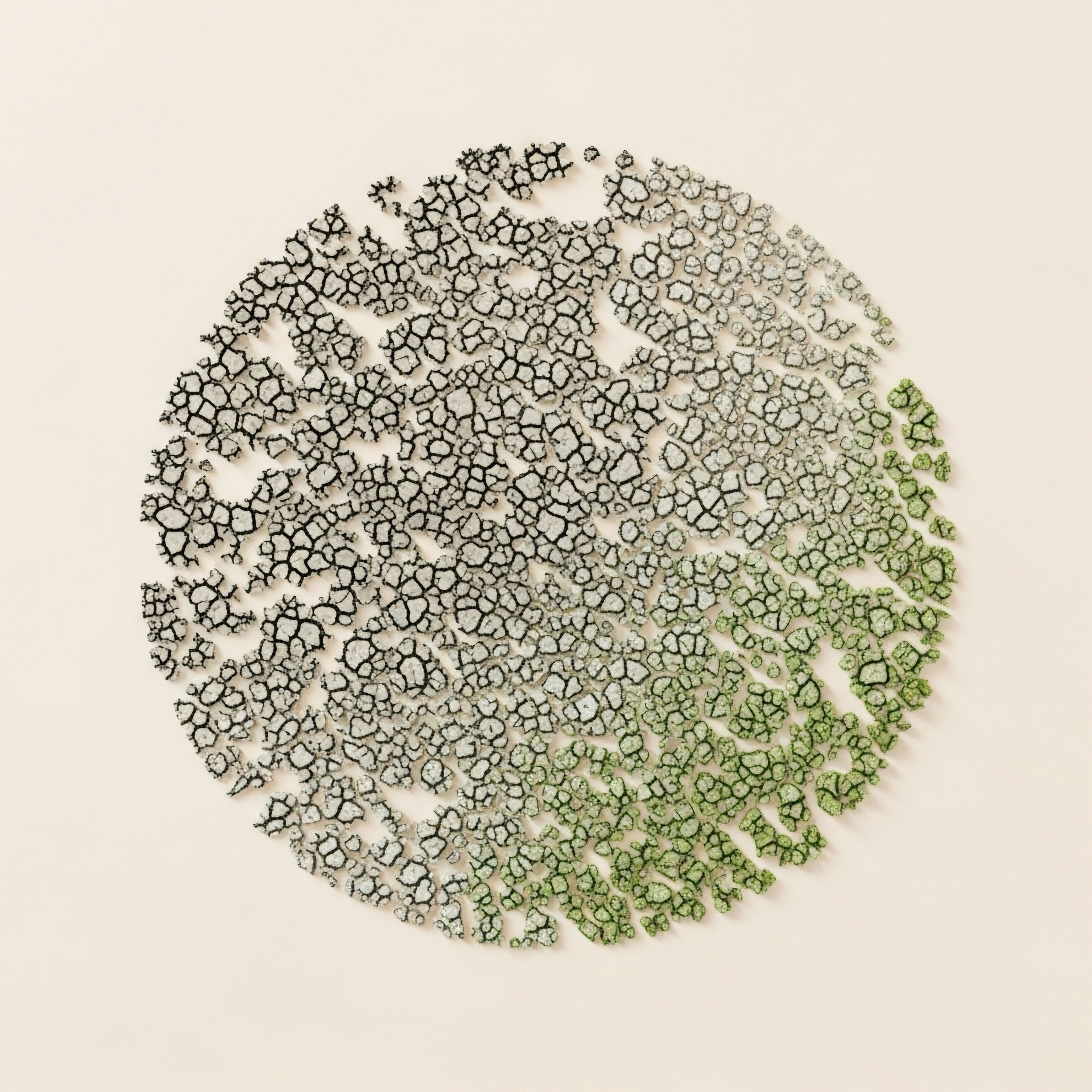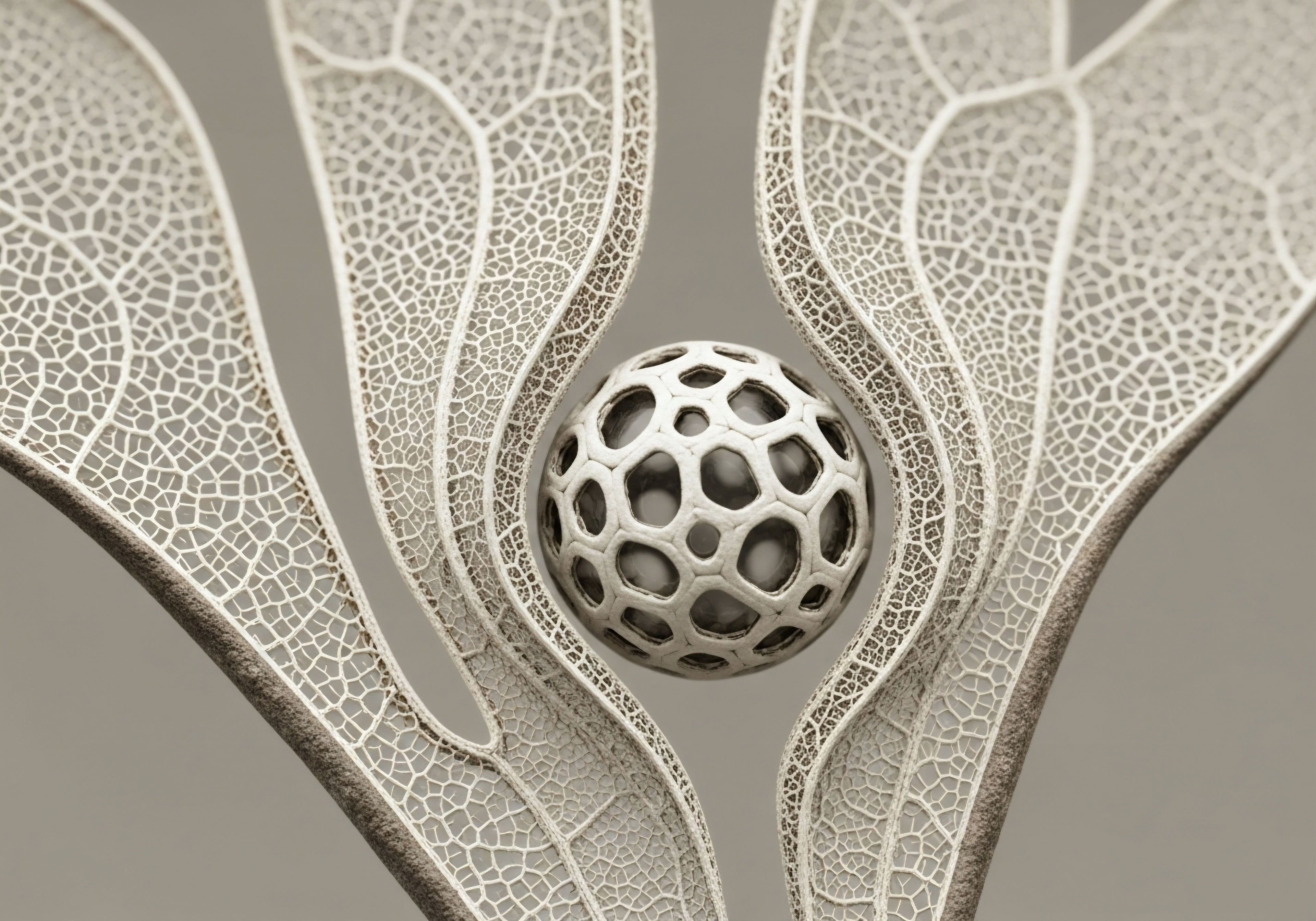

Fundamentals
The thought of damage to the heart brings with it a profound sense of vulnerability. This organ, the very metronome of our existence, operates tirelessly in the background of our lives. When its function is compromised, whether through injury or the slow march of time, the search for meaningful intervention becomes deeply personal.
You may be here because you or someone you care about has faced a diagnosis that feels definitive, a condition where the heart muscle has been weakened or scarred. The conventional view often presents this damage as a permanent state, a reality to be managed rather than reversed. It is from this place of concern and a desire for proactive solutions that we can begin to examine the science of healing and regeneration.
Understanding the potential for repair requires us to first look at the heart not as a simple pump, but as a complex, living tissue with its own cellular ecosystem. Following an event like a myocardial infarction, a cascade of biological processes unfolds.
A lack of oxygenated blood leads to the death of cardiomyocytes, the specialized muscle cells responsible for contraction. The body’s immediate response is one of crisis management. An intense inflammatory process begins, clearing away dead cells and debris. To maintain the heart’s structural integrity, this is followed by the formation of scar tissue.
This fibrotic tissue, composed mainly of collagen, is a biological patch. It prevents the heart wall from rupturing, yet it is non-contractile and stiff. This scarring process, while essential for short-term survival, ultimately impairs the heart’s ability to pump blood efficiently, which can lead to heart failure. The adult heart’s capacity for self-repair is exceedingly limited, which is why this scar formation becomes the default, and often final, outcome.

The Cellular Language of Peptides
Within this context, the scientific community has turned its attention to the body’s own signaling molecules for potential answers. Peptides are short chains of amino acids, the fundamental building blocks of proteins. Think of them as concise biological messages, carrying specific instructions from one cell to another.
Hormones like insulin are peptides; so are many neurotransmitters. Their power lies in their specificity. A particular peptide can bind to a receptor on a cell’s surface and deliver a precise command, such as initiating growth, reducing inflammation, or migrating to a site of injury. This is the core principle behind exploring peptide therapies.
The goal is to use these targeted messages to influence the cellular environment of the damaged heart, steering it away from simple scarring and toward a more functional, regenerative healing process.
The investigation into peptide-based therapies has provided a new approach to cardiac regeneration, aiming to supplement the heart’s poor natural regenerative capacity.
The exploration of peptides for cardiac repair is grounded in the idea of augmenting the body’s innate, yet insufficient, healing systems. These therapies are not introducing a foreign concept to the body. They are designed to amplify a language the cells already speak.
By supplying a higher concentration of a specific “repair” message, the objective is to tip the biological balance in favor of regeneration. This involves several potential mechanisms that researchers are actively investigating. These include protecting the remaining heart cells from further damage, stimulating the formation of new blood vessels to improve oxygen supply, and modulating the inflammatory response to reduce excessive scarring.

What Defines Cardiac Tissue Damage?
To appreciate the challenge and the potential of regenerative therapies, it is important to visualize what happens at the microscopic level. Cardiac damage is a multi-stage process that alters the very architecture of the heart muscle.
- Ischemia and Cell Death ∞ The initial event is typically a loss of blood flow (ischemia), which starves the cardiomyocytes of oxygen and nutrients, leading to programmed cell death, or apoptosis.
- Inflammation and Fibrosis ∞ The body’s immune system rushes to the site, causing inflammation. This is followed by the activation of cells called fibroblasts, which deposit collagen and form the fibrotic scar tissue that replaces the functional muscle.
- Adverse Remodeling ∞ Over time, the presence of this stiff, non-functional scar tissue forces the remaining healthy heart muscle to work harder. This strain can cause the heart to change shape and size, a process known as adverse remodeling, which further degrades its function.
The central question for researchers is whether peptide therapies can intervene at one or more of these stages. Can they protect cells during ischemia, guide the inflammatory response toward regeneration, limit the extent of fibrosis, and ultimately encourage the growth of new, functional heart tissue? The journey to answer this begins with understanding the specific messages these peptides carry.


Intermediate
Moving from the conceptual to the specific, the investigation into peptide therapies for cardiac repair focuses on a select group of molecules, each with a distinct and well-defined mechanism of action. These are not general “healing” agents; they are specialized tools designed to interact with precise biological pathways involved in tissue regeneration.
Understanding their individual roles provides a clearer picture of how a multi-faceted repair process could be orchestrated at the cellular level. The primary candidates in this field work by promoting cell survival, enhancing blood vessel growth, and modulating the body’s response to injury.

Key Peptides in Cardiac Research
Several peptides have become focal points of preclinical research due to their observed effects on cardiovascular tissues. While human clinical application remains largely investigational, the data from laboratory and animal models provide a strong rationale for their continued study. Two of the most prominent are Thymosin Beta-4 and BPC-157.

Thymosin Beta-4 the Pro-Survival and Migratory Signal
Thymosin Beta-4 (Tβ4), and its synthetic counterpart TB-500, is a naturally occurring peptide found throughout the body. Its primary known function is to bind to actin, a protein essential for cell structure and movement. This function is central to its regenerative potential. After a cardiac injury, Tβ4 has been shown to exert several beneficial effects:
- Cardioprotection ∞ It helps protect cardiomyocytes from apoptosis (programmed cell death) in the low-oxygen environment that follows a heart attack. Preserving these existing muscle cells is the first line of defense against functional decline.
- Cell Migration ∞ By interacting with actin, Tβ4 promotes the movement of cells. This is critical for directing progenitor cells ∞ early-stage cells that can develop into more specialized types ∞ to the site of injury where they can contribute to repair.
- Angiogenesis ∞ Tβ4 stimulates the formation of new blood vessels, a process vital for restoring oxygen and nutrient supply to the damaged tissue.
- Anti-inflammatory Action ∞ It helps to downregulate inflammatory cytokines, tempering the inflammatory response that can lead to excessive scarring.
Research suggests Tβ4 may even help reactivate developmental programs within the adult heart, encouraging it to behave more like an embryonic heart, which has a much greater capacity for regeneration. This involves activating the outer layer of the heart, the epicardium, which is a source of progenitor cells during development.

BPC-157 the Angiogenic and Protective Agent
Body Protective Compound 157 (BPC-157) is a synthetic peptide derived from a protein found in human gastric juice. Its stability and potent protective effects have made it a subject of intense research. In the context of cardiovascular health, its primary actions are centered on blood vessels and cytoprotection (direct cell protection).
BPC-157 is considered a potent angiomodulatory agent, meaning it helps optimize the vascular response to injury through various pathways.
The mechanisms of BPC-157 are particularly relevant to overcoming the consequences of vascular blockage that defines a heart attack. Its key functions include:
- Potent Angiogenesis ∞ BPC-157 strongly promotes the formation of new blood vessels. It appears to do this by upregulating key growth factors like Vascular Endothelial Growth Factor (VEGF). This action helps create natural bypasses around blocked or damaged vessels, re-establishing blood flow.
- Endothelial Protection ∞ It directly protects the endothelium, the delicate inner lining of blood vessels, from damage. A healthy endothelium is crucial for regulating blood pressure and preventing clot formation.
- Counteracting Thrombosis ∞ Studies in animal models have shown that BPC-157 can counteract the formation of blood clots without negatively affecting normal coagulation pathways.
- Modulation of Nitric Oxide (NO) ∞ It appears to regulate the nitric oxide system, which is essential for maintaining vascular tone and healthy blood flow.
The combined effect is a therapy that not only helps repair tissue but also addresses the underlying vascular issues that contribute to cardiac damage in the first place.

Comparative Mechanisms of Action
To clarify the distinct yet complementary roles of these peptides, a direct comparison is useful. While both aim to promote healing, they achieve this through different primary pathways.
| Mechanism | Thymosin Beta-4 (Tβ4) | BPC-157 |
|---|---|---|
| Primary Focus | Cell survival, migration, and differentiation. | Blood vessel formation (angiogenesis) and protection. |
| Key Action | Binds to actin to promote cell motility and protects cells from apoptosis. | Upregulates VEGF and modulates nitric oxide to build new vessels. |
| Effect on Inflammation | Reduces inflammatory cytokines, limiting scar-forming inflammation. | Protects tissues from inflammatory damage, supporting a healthier healing environment. |
| Progenitor Cells | Activates and recruits endogenous cardiac progenitor cells. | Creates a vascular network that supports the survival of all cells, including progenitors. |

How Might Peptides Be Applied in a Clinical Context?
The translation of this research into human therapy is a complex process. A significant challenge is delivery. For a peptide to work, it must reach the target tissue in a sufficient concentration. Current research in animal models often involves direct injection into the heart muscle at the time of an induced heart attack.
For human application, less invasive methods like systemic (intravenous or subcutaneous) injections are being explored. The stability of peptides like BPC-157, which can even be administered orally in some contexts, makes them particularly interesting. Researchers are also investigating the timing of administration.
Giving a peptide like Tβ4 immediately after a cardiac event could protect existing cells from dying, while later administration might focus more on remodeling the scar tissue and promoting new vessel growth. The ultimate goal is a protocol that can be administered safely and effectively to improve long-term outcomes after cardiac injury.


Academic
A sophisticated examination of peptide-mediated cardiac repair requires moving beyond a general survey of candidate molecules to a deep analysis of the specific molecular pathways they modulate. The adult mammalian heart’s inability to regenerate is not due to a complete absence of regenerative signals, but rather to the dominance of inhibitory pathways and an insufficient pro-regenerative response following injury.
The academic inquiry, therefore, centers on how exogenous peptides can recalibrate this cellular environment. The case of Thymosin Beta-4 (Tβ4) provides a compelling model for this, as its pleiotropic effects converge on a critical, yet dormant, developmental process ∞ the reactivation of the adult epicardium.

The Epicardium the Dormant Regenerative Hub
The epicardium is the outermost mesothelial layer of the heart. During embryonic development, it is a dynamic and crucial source of progenitor cells. These epicardial-derived progenitor cells (EPDCs) undergo an epithelial-to-mesenchymal transition (EMT), migrating into the underlying myocardium and differentiating into various cardiac cell types, including coronary vascular cells (smooth muscle and endothelial cells) and cardiac fibroblasts.
A limited number also appear to differentiate into cardiomyocytes. In the adult heart, this regenerative potential is largely quiescent. Following a myocardial infarction, there is a modest activation of the epicardium, but it is insufficient to mount a meaningful regenerative response. The research into Tβ4 suggests it can directly stimulate this dormant layer, reawakening its embryonic capabilities.
The scientific consensus from multiple in-vivo studies is that Tβ4 can initiate simultaneous myocardial and vascular regeneration, in part by reminding the adult heart of its embryonic developmental program.
This reactivation is not a generic healing response; it is the triggering of a specific and complex biological program. Studies have demonstrated that systemic administration of Tβ4 in murine models of myocardial infarction leads to a thickening of the epicardial layer and an increase in the population of progenitor cells, independent of the injury itself. This indicates Tβ4 is not just mitigating damage but is actively initiating a pro-regenerative state.

Molecular Mechanism Tβ4, Integrin-Linked Kinase, and Akt Signaling
The central mechanism for Tβ4’s action on cell survival and migration involves the activation of a key enzyme ∞ Integrin-Linked Kinase (ILK). ILK is a crucial component of the cellular machinery that connects the external environment (via integrin receptors) to the internal actin cytoskeleton. By activating ILK, Tβ4 initiates a signaling cascade with profound consequences for the cardiomyocyte.
The downstream effector of ILK activation is the protein kinase Akt (also known as Protein Kinase B). The phosphorylation and activation of Akt by the Tβ4-ILK axis is a pivotal event for cardioprotection. Activated Akt promotes cell survival through multiple avenues:
- Inhibition of Apoptosis ∞ Akt phosphorylates and inactivates several pro-apoptotic proteins, including Bad and caspase-9, directly blocking the cellular machinery of programmed cell death. This is critical for preserving myocardial tissue in the hypoxic conditions following infarction.
- Promotion of Growth ∞ The Akt pathway is a central regulator of cell growth and proliferation, integrating signals from various growth factors.
- Metabolic Regulation ∞ Akt enhances glucose uptake and utilization, providing much-needed energy to stressed cardiomyocytes.
This Tβ4-ILK-Akt pathway is a powerful pro-survival signal that directly counteracts the ischemic damage cascade. It is this mechanism that underpins the observation in animal models that Tβ4 administration reduces infarct size and preserves cardiac function.

What Are the Limits of Epicardial Activation in Humans?
While the evidence from small animal models is compelling, a significant question remains regarding its translatability to human physiology. The regenerative capacity of the neonatal mouse heart, which is often used as a benchmark, is lost within the first week of life. The adult human heart is far removed from this regenerative window.
The scientific debate continues on the true differentiation potential of adult human EPDCs. While Tβ4 can clearly induce their migration and proliferation, their capacity to become new, fully integrated cardiomyocytes in a clinical setting is still a subject of intense investigation.
Some studies suggest the primary benefit of activating these cells may be their paracrine effects ∞ their secretion of growth factors that support surrounding tissue and promote angiogenesis ∞ rather than direct replacement of lost muscle. This distinction is critical for setting realistic therapeutic expectations.
| Signaling Component | Role in Cardiac Regeneration | Primary Outcome |
|---|---|---|
| Thymosin Beta-4 (Tβ4) | Exogenous peptide that initiates the signaling cascade. | Binds to cell surface receptors, activating ILK. |
| Integrin-Linked Kinase (ILK) | A serine/threonine kinase that acts as a central signaling hub. | Phosphorylates and activates its primary downstream target, Akt. |
| Akt (Protein Kinase B) | A key regulator of cell survival, growth, and metabolism. | Inhibits apoptotic pathways and promotes cardiomyocyte viability. |
| Epicardial Progenitor Cells (EPDCs) | Dormant progenitor cells in the outer layer of the adult heart. | Activated by Tβ4 to proliferate, migrate, and secrete paracrine factors. |

Future Directions and Clinical Hurdles
The path from these molecular insights to a viable human therapy is fraught with challenges. The development of a therapeutic monoclonal antibody that blocks the protein ENPP1, which promotes inflammation and scarring, represents another angle of attack that is already moving toward clinical trials. This highlights a broader strategy ∞ combining different therapeutic approaches.
A future protocol might involve an agent like an ENPP1 inhibitor to create a less hostile, pro-regenerative environment, followed by a peptide like Tβ4 to actively stimulate repair mechanisms. Further research must also optimize dosing, delivery methods, and the therapeutic window for administration. The promise of directly repairing cardiac tissue is immense, but it requires a rigorous, mechanistically-driven approach to overcome the heart’s profound resistance to healing.

References
- Sienkiewicz, D. et al. “BPC 157 and blood vessels.” Current Pharmaceutical Design, vol. 23, no. 41, 2017, pp. 6248-6259.
- Bock-Marquette, I. et al. “Thymosin β4 activates integrin-linked kinase and promotes cardiac cell migration, survival and cardiac repair.” Nature, vol. 432, no. 7016, 2004, pp. 466-472.
- Hsieh, P. C. H. and D. Srivastava. “Thymosin beta4 and cardiac repair.” Annals of the New York Academy of Sciences, vol. 1194, 2010, pp. 87-96.
- Evans, Z. “A New Peptide Could Help Repair and Protect the Heart During Ischemia Reperfusion Injury.” Labroots, 3 Nov. 2020.
- Smart, N. et al. “Thymosin β4 and the epicardium in cardiac regeneration.” Annals of the New York Academy of Sciences, vol. 1228, 2011, pp. 129-135.
- Chan, M. K. S. et al. “Peptides in Cardiology ∞ Preventing Cardiac Aging and Reversing Heart Disease.” Advances in Clinical Medicine and Research, vol. 5, no. 4, 2024, pp. 1-16.
- Gojkovic, S. et al. “Stable Gastric Pentadecapeptide BPC 157 as Useful Cytoprotective Peptide Therapy in the Heart Disturbances, Myocardial Infarction, Heart Failure, Pulmonary Hypertension, Arrhythmias, and Thrombosis Presentation.” Pharmaceuticals, vol. 14, no. 10, 2021, p. 984.
- Deb, A. et al. “A therapeutic monoclonal antibody against ENPP1 enhances cardiac repair after myocardial infarction.” Cell Reports Medicine, vol. 5, no. 11, 2024, 101779.

Reflection

Calibrating the Blueprint for Your Own Biology
The information presented here represents a frontier of medical science, a place where our understanding of the body’s own systems is being leveraged to create new possibilities for healing. The journey through the cellular mechanisms of cardiac repair, from the fundamental role of peptides to the academic intricacies of epicardial activation, provides a detailed map of this emerging landscape.
This map is a tool for understanding, designed to translate the complex language of the laboratory into a coherent narrative of potential.
Your own health story is unique, written in the language of your personal biology, experiences, and goals. The knowledge of how peptides like Thymosin Beta-4 or BPC-157 function is not an endpoint. It is a new set of coordinates from which to view your own path forward.
It allows for a different kind of conversation, one grounded in the mechanics of cellular function and the proactive pursuit of regeneration. The true application of this knowledge lies in how it informs your perspective and empowers your decisions.
Consider the systems within your own body. The intricate communication between cells, the delicate balance of inflammation and repair, and the dormant potential for regeneration are all part of your biological inheritance. The exploration of peptide therapies is, at its core, an attempt to learn the grammar of these systems well enough to participate in the conversation.
As you move forward, the most valuable step is to take this understanding and use it as the foundation for a personalized dialogue with a clinical expert who can help translate this scientific potential into a strategy that aligns with the unique architecture of your own health.



